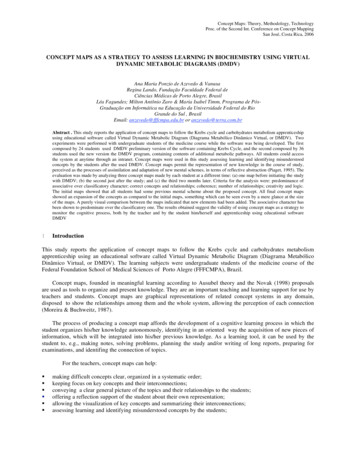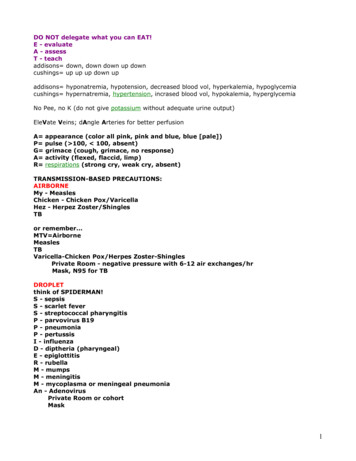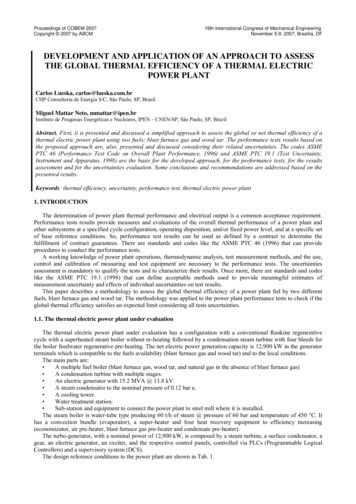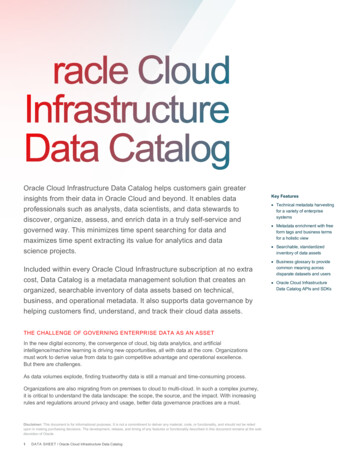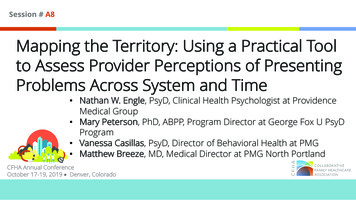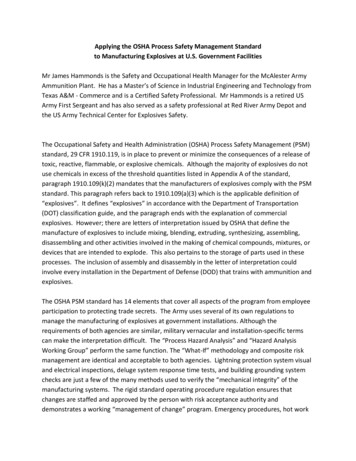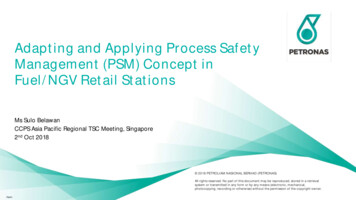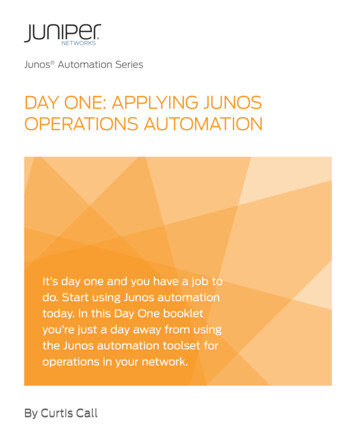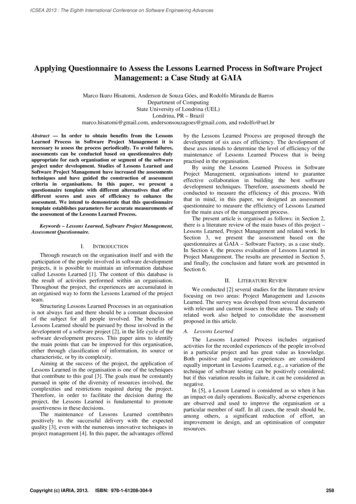
Transcription
ICSEA 2013 : The Eighth International Conference on Software Engineering AdvancesApplying Questionnaire to Assess the Lessons Learned Process in Software ProjectManagement: a Case Study at GAIAMarco Ikuro Hisatomi, Anderson de Souza Góes, and Rodolfo Miranda de BarrosDepartment of ComputingState University of Londrina (UEL)Londrina, PR – Brazilmarco.hisatomi@gmail.com, andersonsouzagoes@gmail.com, and rodolfo@uel.brAbstract — In order to obtain benefits from the LessonsLearned Process in Software Project Management it isnecessary to assess the process periodically. To avoid failures,assessments can be conducted based on questionnaires dulyappropriate for each organisation or segment of the softwareproject under development. Studies of Lessons Learned andSoftware Project Management have increased the assessmentstechniques and have guided the construction of assessmentcriteria in organisations. In this paper, we present aquestionnaire template with different alternatives that offerdifferent scores and axes of efficiency to enhance theassessment. We intend to demonstrate that this questionnairetemplate establishes parameters for accurate measurements ofthe assessment of the Lessons Learned Process.Keywords – Lessons Learned, Software Project Management,Assessment Questionnaire.I.INTRODUCTIONThrough research on the organisation itself and with theparticipation of the people involved in software developmentprojects, it is possible to maintain an information databasecalled Lessons Learned [1]. The content of this database isthe result of activities performed within an organisation.Throughout the project, the experiences are accumulated inan organised way to form the Lessons Learned of the projectteam.Structuring Lessons Learned Processes in an organisationis not always fast and there should be a constant discussionof the subject for all people involved. The benefits ofLessons Learned should be pursued by those involved in thedevelopment of a software project [2], in the life cycle of thesoftware development process. This paper aims to identifythe main points that can be improved for this organisation,either through classification of information, its source orcharacteristic, or by its complexity.Aiming at the success of the project, the application ofLessons Learned in the organisation is one of the techniquesthat contribute to this goal [3]. The goals must be constantlypursued in spite of the diversity of resources involved, thecomplexities and restrictions required during the project.Therefore, in order to facilitate the decision during theproject, the Lessons Learned is fundamental to promoteassertiveness in these decisions.The maintenance of Lessons Learned contributespositively to the successful delivery with the expectedquality [3], even with the numerous innovative techniques inproject management [4]. In this paper, the advantages offeredCopyright (c) IARIA, 2013.ISBN: 978-1-61208-304-9by the Lessons Learned Process are proposed through thedevelopment of six axes of efficiency. The development ofthese axes intends to determine the level of efficiency of themaintenance of Lessons Learned Process that is beingpractised in the organisation.By using the Lessons Learned Process in SoftwareProject Management, organisations intend to guaranteeeffective collaboration in building the best softwaredevelopment techniques. Therefore, assessments should beconducted to measure the efficiency of this process. Withthat in mind, in this paper, we designed an assessmentquestionnaire to measure the efficiency of Lessons Learnedfor the main axes of the management process.The present article is organised as follows: in Section 2,there is a literature review of the main bases of this project –Lessons Learned, Project Management and related work. InSection 3, we present the assessment based on thequestionnaires at GAIA – Software Factory, as a case study.In Section 4, the process evaluation of Lessons Learned inProject Management. The results are presented in Section 5,and finally, the conclusion and future work are presented inSection 6.II.LITERATURE REVIEWWe conducted [2] several studies for the literature reviewfocusing on two areas: Project Management and LessonsLearned. The survey was developed from several documentswith relevant and current issues in these areas. The study ofrelated work also helped to consolidate the assessmentproposed in this article.A. Lessons LearnedThe Lessons Learned Process includes organisedactivities for the recorded experiences of the people involvedin a particular project and has great value as knowledge.Both positive and negative experiences are consideredequally important in Lessons Learned, e.g., a variation of thetechnique of software testing can be positively considered;but if this variation results in failure, it can be considered asnegative.In [5], a Lesson Learned is considered as so when it hasan impact on daily operations. Basically, adverse experiencesare observed and used to improve the organisation or aparticular member of staff. In all cases, the result should be,among others, a significant reduction of effort, animprovement in design, and an optimisation of computerresources.258
ICSEA 2013 : The Eighth International Conference on Software Engineering AdvancesAmong the several applications of Lessons Learned, withbeneficial impacts to the organisation, some can be citedaccording to [3]: Time saved in solving problems, since the solutionsof common problems are centralised in one locationfor easy access by members. Reduction or elimination of costs from avoiding thesame work to be done again when correctingdiscovered defects. Encouragement of the use of best practices withinthe organisation, which increases the likelihood ofsuccess of the projects.Narratives that explicit knowledge or understandinggained through experience – both positive and negative – canstill be characterised as a lesson learned. The lesson relateswhat was expected to happen, the facts and deviations thathappened, the analysis of the causes of these deviations andwhat might be learned during the process [6].The record of the lessons learned is an excellent way toavoid the same mistakes previously made and to replicate thesuccesses achieved in the past to future projects. Accordingto [7], five points are listed for a successful implementationof the process of documentation of the lessons learned:1) Training of members of the organisation – it isnecessary to change the paradigm that the collection andrecording of lessons learned is a waste of time, and to bringto knowledge the benefits that information sharing has in anorganisation. For this process to work, it is very importantthat the manager is able to generate motivation andinvolvement of all. According to [8], to make full use of thepractices of knowledge management in a company, one ofthe key factors is the involvement of both stakeholders andworkforce – which involves a change of habits.2) Collection and recording of experiences – this task isconsidered to be costly and demands great effort from thestaff. This task should be performed using practices andoriented towards an easy method of items relevant for theorganisation; also, it is important that these items areorganised following a set pattern.3) Analysis of successes and failures – it is not enoughthat the lessons learned are simply recorded and catalogued;they also must be understood and analysed. After theidentification of the activities that resulted in good results orfailures, these records must be part of the knowledge basis.In that way, the Lessons Learned Process becomes anopportunity for analysing facts and for adopting measures fora continuous improvement.4) Dissemination of knowledge – Simply archiving theselessons is not enough; they should also be disclosedthroughout the organisation. This disclosure must take intoaccount the direction and prioritisation of such informationin accordance with the interests of each group.5) Updated records – It is very important to understandthat the register of the Lessons Learned should be cyclical,i.e., it must be constantly updated.Copyright (c) IARIA, 2013.ISBN: 978-1-61208-304-9B. Project ManagementSoftware development has been one of the majortechnological advances of our days, in the information age.All products built based on projects have shown positiveresults and measurable improvements in the future [4]. Forthat, project management is an activity largely applied tosoftware development, which has improved significantlywith less effort.The most widely accepted definition for the term"project" is presented by the Project Management Body ofKnowledge (PMBOK), and characterised as "a temporaryendeavour undertaken to create a product, service or resultonly". In the same line, [9] defines it as "a unique venture toproduce a set of results according to constraints of time, costand quality clearly defined".The great amount of software projects in progress, thenumber of people involved in these tasks and the tightdelivery deadlines increases the complexity of these projects[10]. Therefore, there is a growing practice of ProjectManagement (PM) for new software projects, whether newproducts or changes in systems already developed.According to [11], PM is used by organisations to managethe innovations in their processes. Thus, encouraging thecreation and dissemination of organisational managementtechniques in these organisations is fundamental to improveproducts and processes services.According to [12], there is the PM-specific branch of theorganisation’s activity, because it includes varioustechniques in different business areas, such as: generaladministration, military organisation and engineering, amongothers. The activities involved in PM are multidisciplinaryand require a lot of expertise and the participants'commitment to its implementation. The growth of projectmanagement refers to topics such as roles andresponsibilities, organisational structures, delegation ofauthority, decision-making and especially corporateprofitability [13].Thus, the project management "is the application ofknowledge, skills, tools and techniques to project activities tomeet project requirements". Once the characteristics of thedelivery products (and services) [4] [9] are defined, theactivities must meet these objectives in an explicit – and notimplicit – way. Throughout their development, the projectsare organised according to their life cycle and divided in twoclasses: the projects that involve the activities of PM and theproducts that include the activities of product development[12].During the development of a product, the tasks may varyaccording to the branch of industry (software,pharmaceutical, manufacturing, etc.), while the PM isindependent from the segment. They can be classified intogroups (called stages), such as initiation, definition,planning, execution, controlling, and closing. Each stagebrings together activities with similar purposes, but withtheir own features and goals.C. Related Work Process and Lessons LearnedThe Process Management of the Lessons Learned isincreasing, especially in the area of Information Technology,259
ICSEA 2013 : The Eighth International Conference on Software Engineering Advancesaiming at consolidating this process in software projects. Forexample, [14] proposes an architectural model for managingLessons Learned in the testing phase. Although there arestudies reporting the importance of this process, none ofthem includes the assessment questionnaire.In the work of [15], the authors developed a guidecontaining major errors in the Lessons Learned. This subjectwas widely discussed by National Aeronautics and SpaceAdministration (NASA) especially after the incident with thespace shuttle Columbia. These authors’ proposal is toconsider the following key steps: the collection of lessonslearned, their management and application in future projects.According to [16], Lessons Learned Process is used todevelop and maintain an organisational memory for atechnology centre that develops high risk systems. In thiscentre, through interviews, decomposition and reintegrationof tacit knowledge with explicit information, including theinformation gathering and dissemination, they managed toestablish a process and obtained good results after itsimplementation.In software engineering, the process of knowledgedissemination is based on Lessons Learned [17] in order tomaintain a community of interest. This work describes theoperation of the engineering centre software based onCommercial Off-The-Shelf (COTS) and how the LessonsLearned is used. It also includes a detailed description of arepository Lessons Learned and a planning evolution for it.As previously mentioned, the use of Lessons LearnedProcess has clear aims in project management, which in turnrequires the assessment of this process so that improvementscan take place. Several studies focus on Lessons LearnedProcess, highlighting its necessity and advantages. However,the formal and effective assessment of this process is notalways correctly explained.In this paper, a formal assessment with the aim ofimproving Lessons Learned Process is proposed through aquestionnaire applied to all involved in the project. Based onthe results of this questionnaire, the organisation can decidehow to employ its resources for each level of need indicatedby the axes of efficiency.III.ASSESSMENT OF LESSONS LEARNED PROCESS BASEDThe team works with procedures, attributes andtemplates that can be reused; An organisation focused on a continuousimprovement of its processes; The development software process includesintegration at several software engineering area andgovernance in Information Technology (IT); Specialists in knowledge management; Experienced staff in project management.In the work of [19], a method was used for multiple-itemdevelopment of a questionnaire. The main objective of thismethod was the measurement of a universe through i
Keywords – Lessons Learned, Software Project Management, Assessment Questionnaire. I. INTRODUCTION Through research on the organisation itself and with the participation of the people involved in software development projects, it is possible to maintain an information database called Lessons Learned [1]. The content of this database is the result of activities performed within an .
